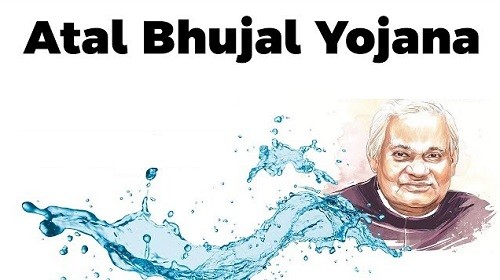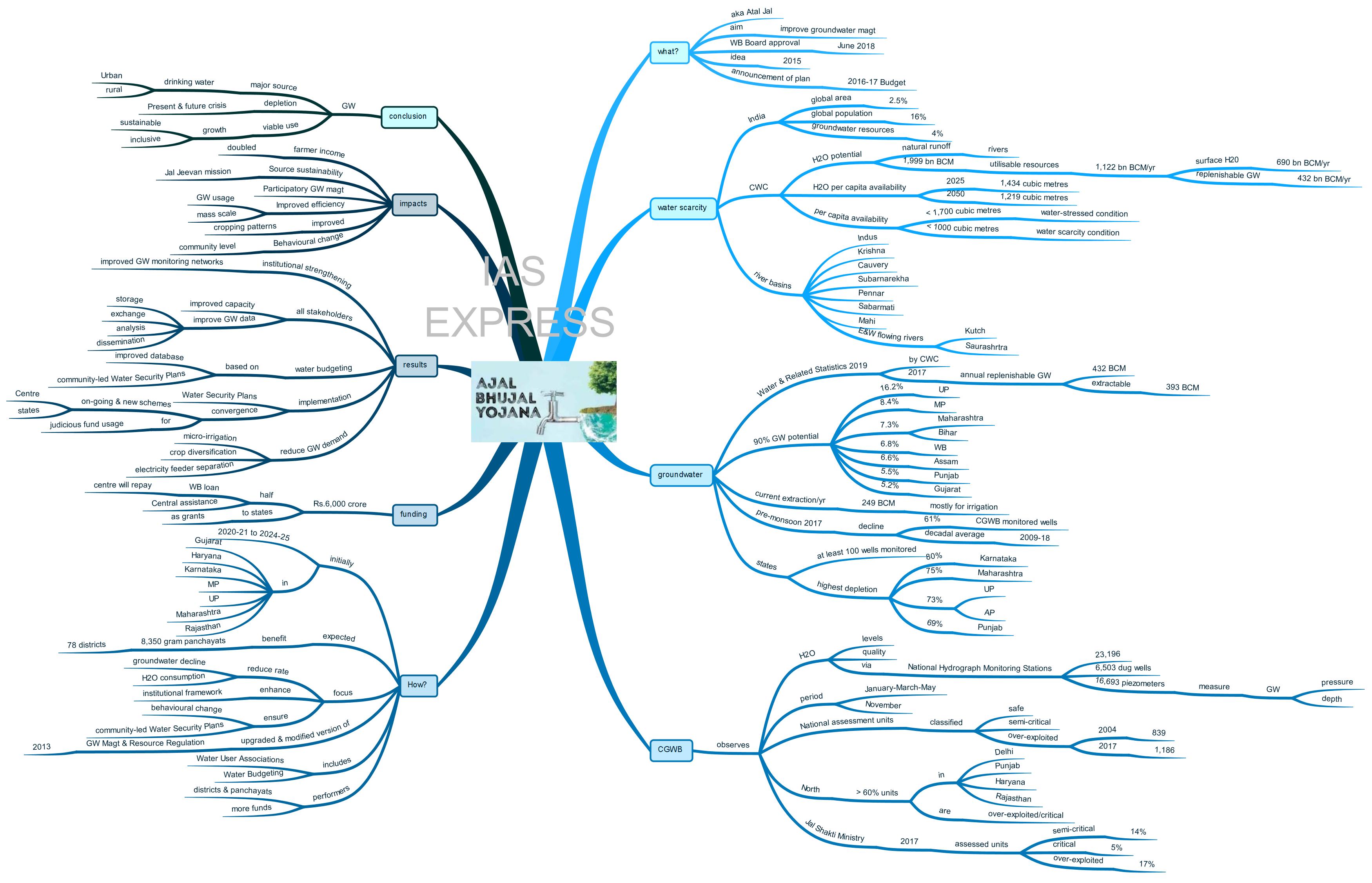Atal Bhujal Yojana – Will it Solve India’s Water Crisis?

Prime Minister Narendra Modi had recently launched Atal Bhujal Yojana (ABY) to promote sustainable management of groundwater resources in India. This scheme was launched on the 95th birth anniversary of former Prime Minister Atal Bihari Vajpayee.
This topic of “Atal Bhujal Yojana – Will it Solve India’s Water Crisis?” is important from the perspective of the UPSC IAS Examination, which falls under General Studies Portion.
What is Atal Bhujal Yojana (ABY)?
- Atal Bhujal Yojana or Atal Jal is a world bank funded central scheme that aims to improve the groundwater management at the national level.
- The World Bank Board approved it in June 2018.
- The idea to address the country’s depleting groundwater resources came up in 2015.
- The government announced its intention in the 2016-17 Budget with an estimated cost of about Rs.6,000 crore.
How scarce is water in India?
- India holds 2.5% of the global area and is the home to 16% of the global population. Yet, it has access to just 4% of the global water resources.
- According to the Central Water Commission (CWC), it is estimated that India’s water resource potential, which occurs as natural runoff in the rivers, is 1,999 billion cubic metres.
- Of this, the estimated utilisable resources are 1,122 billion cubic metres per annum – 690 billion cubic metre per year surface water and 432 billion cubic metres per year replenishable groundwater.
- With the increasing population, the demand for water will increase exponentially in the coming years.
- According to the CWC, the per capita availability of water in the country will decrease from 1,434 cubic metres in 2025 to 1,219 cubic metres in 2050.
- According to the CWC, a water-stressed condition occurs when the per capita availability is less than 1,700 cubic metres and a water scarcity condition occurs when the per capita availability is less than 1,000 cubic metres.
- Some river basins within India are currently facing water scarcity. These include the Indus, Krishna, Cauvery, Subarnarekha, Pennar, Mahi, Sabarmati and east-flowing rivers and west-flowing rivers of Kutch and Saurashtra including Luni.
What is the situation of groundwater in India?
- As per the report published by the CWC called the “Water and Related Statistics 2019”, in 2017, India’s annual replenishable groundwater resources are 432 BCM.
- Of the 432 BCM replenishable groundwater, 393 BCM is the annual ‘extractable’ groundwater availability.
- Fifteen states account for about 90% of the groundwater potential in the country.
- Uttar Pradesh accounts for 16.2%, followed by Madhya Pradesh (8.4%), Maharashtra (7.3%), Bihar (7.3%), West Bengal (6.8%), Assam (6.6%), Punjab (5.5%) and Gujarat (5.2%).
- The current annual groundwater extraction is 249 BCM, mostly used for irrigation purposes.
- This is the reason behind the government’s calls for alternatives to water-intensive crops like paddy and sugarcane.
- During pre-monsoon of 2017, when compared with the decadal average for 2009-18, there has been a decline in the groundwater level in 61% of the wells monitored by the Central Ground Water Board (CGWB).
- Among the states where at least 100 wells were monitored, the highest depletion was seen in Karnataka (80%), Maharashtra (75%), Uttar Pradesh (73%), Andhra Pradesh (73%) and Punjab (69%).
What does CGWB do?
- The Central Ground Water Board (CGWB) observes the water levels and quality via a network of 23,196 “National Hydrograph Monitoring Stations” (6,503 dug wells and 16,693 piezometers). Piezometers are devices used to measure the pressure or depth of the groundwater.
- CGWB monitors in January-March-May and November each year.
- The Board has classified the nation’s assessment units (blocks, taluks, mandals etc.) into safe, semi-critical and over-exploited in terms of groundwater resources.
- The number of over-exploited units has increased from 839 units in 2004 to 1,186 in 2017.
- In the north, more than 60% of the assessment units in Delhi, Punjab, Haryana and Rajasthan are either over-exploited or critical.
- During the Monsoon Session of the Parliament, the Jal Shakti Ministry has stated that as of 2017, 14% of the country’s assessed units are semi-critical, 5% are critical and 17% are over-exploited.
How is Atal Bhujal Yojana going to address this situation?
- Initially, the Atal Bhujal Yojana will be implemented in seven states (Gujarat, Haryana, Karnataka, Madhya Pradesh, Maharashtra, Rajasthan and Uttar Pradesh) over five years (2020-21 to 2024-25).
- This initiative is expected to benefit about 8,350 gram panchayats in 78 districts.
- If successful, the initiative may be extended to other parts of the country.
- The focus of the ABY will on reducing the rate of declining groundwater levels as well as water consumption.
- It will also aim to enhance the institutional framework and ensure behavioural change at the community level for sustainable groundwater resource management.
- It also envisages community-led Water Security Plans.
- This scheme is the updated and modified version of the Groundwater Management and Resource Regulation scheme of 2013 that aimed to manage the nation’s groundwater resources.
- The new scheme includes concepts like “Water User Associations” and Water Budgeting.
- The districts and panchayats that perform well will be given more funds.
Who is going to pay for this scheme?
- 50% of the Rs.6,000 crore will be contributed by the World Bank as a loan and the rest of the 50% will be given by the Central Government in the form of central assistance. The Centre will repay the loan borrowed from the World Bank.
- All of the funding from the World Bank and the Centre will be given to the states as grants.
What are the expected results and impacts of this scheme?
Expected Results:
- Institutional strengthening to improve groundwater monitoring networks.
- Capacity improvement of the stakeholders at all levels to enhance groundwater data storage, exchange, analysis and dissemination.
- Improved and realistic water budgeting based on an improved database and community-led Water Security Plans at the Panchayat level.
- Implementation of Water Security Plans through the convergence of all the Central government and state governments’ on-going and new schemes to ensure judicious and effective utilization of funds for sustainable groundwater management.
- Efficient use of available groundwater resources with an emphasis on the aim to reduce the demand through micro-irrigation, crop diversification, electricity feeder separation etc.
Expected impacts:
- Doubling of the farmers’ income;
- Source sustainability for Jal Jeevan mission in the project area with active community participation;
- Participatory groundwater management;
- Improved efficiency of the use of groundwater on a mass scale;
- Improved cropping patterns;
- Behavioural change at the community level that will ensure efficient and judicial use of the groundwater.
Conclusion
The groundwater is the major source of drinking water in both urban and rural India. Its depletion may worsen the water scarcity situation in the future. Thus, viable use of groundwater will ensure sustainable and inclusive growth for all.
Test Yourself
Critically analyse how Atal Bhujal Yojana will address India’s water crisis. (250 Words)


